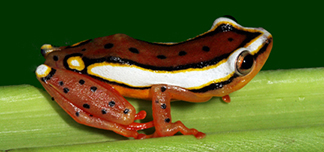Pelobates varaldii is known only from fragmented localized areas along the Atlantic coastal plains of northwestern Morocco, within the Mediterranean forests and woodlands ecoregion. This small fossorial toad is particularly associated with sandy plains near cork oak forests. Diagnostic features include vertical pupils and webbed toes. Breeding sites are ephemeral lentic water bodies, which are scarce in this region. This endangered species is under threat from an expanding human population in the region, with proximate drivers of urbanization, conversion of coastal plains to farmland, and extraction of scarce water resources for human use.
P. varaldi has been classified as as Endangered (B2ab(iii) ver 3.1) by the IUCN since its Area of Occupancy is likely less than 500 square kilometers, and the species distribution is severely fragmented along the northwest Moroccan coastal zone; furthermore, there is a continuing decline in the extent and quality of its habitat in Morocco, due to the growth of the human population and associated exploitation of the coastal zone (Salvatore et al. 2004).
Significant threats are at play, since this part of Morocco is under intense pressure from an expanding human population. Chief manifestations of this pressure is urbanization of the coastal zone, agricultural land conversion on the coastal plain and extraction of surface water resources, which are in scarcity within the species range. In addition there are instances of overgrazing, arising from the pressure of developing food resources for an expanding human population (World Wildlife Fund & Hogan, 2007). These threats are exacerbated by a trend in the last three decades, in which snowmelt has occurred earlier in the season, reducing the amount of late spring runoff and thus reducing formation of ephemeral ponds.
According to the IUCN, there was no information on the population status of P. varaldi, although at that time the species population was thought to be declining (Salvador et al. 2004).
In all of northwestern Africa, there are thirteen species of anurans. P. varaldii is the only anuran with vertical pupils that lacks adhesive tips on fingers and toes and that has the following additional features: black keratinous spade (modified metatarsal tubercle) evident along with two rather small, inconspicuous palmar tubercles and webbed toes. The closest other anuran in morphology is Alytes obstetricians, who lacks webbing, has three palmar tubercles and lacks the keratinous spade (Salvador, 1996).
Further diagnostics of the species are smooth skin, lack of dorsolateral glandular folds, lack of paratoid glands and inconspicuous tympanum (Salvador, 1996).
P. varaldii is a nocturnal anuran, and is active in autumn and winter seasons only. This toad remains buried in the soil during the daytime, and appears to be confined to sandy soils. Prey consist of a variety of invertebrates (Salvador, 1996).
Tadpoles of P. varaldii can attain a length of 13 centimeters (Salvador, 1996).
The species head is wide, with a concave element between the eyes. Nostrils are equidistant between the snout and anterior eye edge. The eyes are prominent, with horizontal diameter greater than distance between eye and nostril. The iris is a yellowish-copper or greenish with black spots. Digits lack articular tubercles. Three inconspicuous palmar tubercles are present. The metatarsal tubercle exhibits a whitish base. The exterior skin is smooth, with small reddish warts on the eyelids and dorsum. The dorsum itself is grayish-brown with irregular dark spots; the venter is whitish.
Some P. varaldii individuals exhibit a metatarsal tubercle that is totally keratinized. Furthermore, a number of the adult population may manifest red spots on their upper eyelids, although such spots are lacking in most individuals (Salvador, 1996).
The adult snout-vent length may achieve 65 millimeters (mm) in the male and 70 mm in the female.(Salvador. 1996)
P. varaldii is known only from fragmented localized areas along the coastal plains of northwestern Morocco. The northernmost location is the town of Larache, while the southernmost population is the northeastern part of the salt marshes of Oualida. The range may continue further south than Oualidia, and this potential range extension merits further field research. Ramos and Hernandez (1986) noted the presence of Pelobates cultripes in the Melilla region of Spain, which observation could refer to P. varaldii, though this record is far outside the known range of any Pelobates species.
While the IUCN classifies the species as freshwater, it is sometimes found in brackish coastal waters.The population of P. varaldii is inherently disjunctive, with the largest contiguous area stretching from the coastal zone north of Larache, Morocco to south of Rabat, Morocco; smaller habitat patches are found further south reaching almost as far as Safi, Morocco. P. varaldii is endemic to the Mediterranean forests and woodlands ecoregion, but is found only on the Atlantic side of that ecoregion, especially on sandy plains near cork oak (Quercus suber) forests (World Wildlife Fund & Hogan, 2007).
P. varaldii is fundamentally fossorial in habit, dwelling chiefly in sandy lowland uncultivated soils, frequently found in the vicinity of cork woodlands. The species breeding sites are most often lentic temporary water bodies, such as, dayas and rain puddles. P. varaldii is not known to be adaptive to anthropogenically modified habitats (Salvador et al. 2004). This species is known to occur only between sea level and 350 meters above sea level (Salvador et al. 2004).
Metamorphosis generally occurs in May or June, and the young exit their surface water body with stubby tails. Newly metamorphosed individuals generally measure 21 to 34 millimeters as a snout-vent length (Salvador, 1996).
Amplexus takes place in the surface breeding waters, with ova-deposition into the waters requiring only five to ten minutes, and eggs being laid in a string 1.0 to 1.5 meters in length. The species typically breeds in temporary ponds or puddles. The eggs themselves are dark grey in color, and each egg measuring 1.15 to 2.00 millimeters in diameter. Larvae hatch within a week after laying. The tadpoles feed on plankton and detritus (Salvador, 1996).
